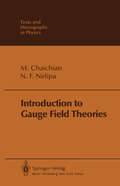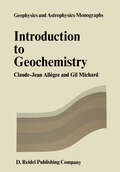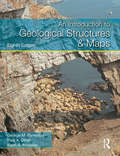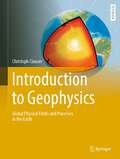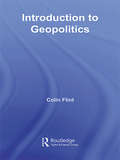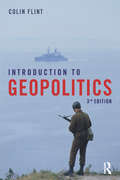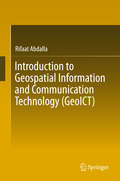- Table View
- List View
Introduction to Fractional and Pseudo-Differential Equations with Singular Symbols (Developments in Mathematics #41)
by Sabir UmarovThe book systematically presents the theories of pseudo-differential operators with symbols singular in dual variables, fractional order derivatives, distributed and variable order fractional derivatives, random walk approximants, and applications of these theories to various initial and multi-point boundary value problems for pseudo-differential equations. Fractional Fokker-Planck-Kolmogorov equations associated with a large class of stochastic processes are presented. A complex version of the theory of pseudo-differential operators with meromorphic symbols based on the recently introduced complex Fourier transform is developed and applied for initial and boundary value problems for systems of complex differential and pseudo-differential equations.
An Introduction to Frozen Ground Engineering
by Orlando B. Andersland B. LadanyiFrozen Ground Engineering first introduces the reader to the frozen environment and the behavior of frozen soil as an engineering material. In subsequent chapters this information is used in the analysis and design of ground support systems, foundations, and embankments. These and other topics make this book suitable for use by civil engineering students in a one-semester course on frozen ground engineering at the senior or first-year-graduate level. Students are assumed to have a working knowledge of undergraduate mechanics (statics and mechanics of materials) and geotechnical engineering (usual two-course sequence). A knowledge of basic geology would be helpful but is not essential. This book will also be useful to advanced students in other disciplines and to engineers who desire an introduction to frozen ground engineering or references to selected technical publications in the field. BACKGROUND Frozen ground engineering has developed rapidly in the past several decades under the pressure of necessity. As practical problems involving frozen soils broadened in scope, the inadequacy of earlier methods for coping became increasingly apparent. The application of ground freezing to geotechnical projects throughout the world continues to grow as significant advances have been made in ground freezing technology. Freezing is a useful and versatile technique for temporary earth support, groundwater control in difficult soil or rock strata, and the formation of subsurface containment barriers suitable for use in groundwater remediation projects.
Introduction to Frustrated Magnetism: Materials, Experiments, Theory (Springer Series in Solid-State Sciences #164)
by Claudine Lacroix Philippe Mendels Édéric MilaThe field of highly frustrated magnetism has developed considerably and expanded over the last 15 years. Issuing from canonical geometric frustration of interactions, it now extends over other aspects with many degrees of freedom such as magneto-elastic couplings, orbital degrees of freedom, dilution effects, and electron doping. Its is thus shown here that the concept of frustration impacts on many other fields in physics than magnetism. This book represents a state-of-the-art review aimed at a broad audience with tutorial chapters and more topical ones, encompassing solid-state chemistry, experimental and theoretical physics.
Introduction to Gauge Field Theories (Theoretical and Mathematical Physics)
by M. Chaichian N. F. NelipaIn recent years, gauge fields have attracted much attention in elementary par ticle physics. The reason is that great progress has been achieved in solving a number of important problems of field theory and elementary particle physics by means of the quantum theory of gauge fields. This refers, in particular, to constructing unified gauge models and theory of strong interactions between the elementary particles. This book expounds the fundamentals of the quantum theory of gauge fields and its application for constructing unified gauge models and the theory of strong interactions. In writing the book, the authors' aim was three-fold: firstly, to outline the basic ideas underlying the unified gauge models and the theory of strong inter actions; secondly, to discuss the major unified gauge models, the theory of strong interactions and their experimental implications; and, thirdly, to acquaint the reader with a rather special mathematical approach (path-in tegral method) which has proved to be well suited for constructing the quantum theory of gauge fields. Gauge fields are a vigorously developing area. In this book, we have select ed for presentation the more or less traditional and commonly accepted mate rial. There also exist a number of different approaches which are presently being developed. The most important of them are touched upon in the Conclusion.
Introduction to Geochemistry (Geophysics and Astrophysics Monographs #10)
by Cl.J. Allègre G. MichardTO GEOCHEMISTRY by CLAUDE-JEAN ALLEGRE Department of Earth Sciences, University of Paris 7 and GIL MICHARD Department of Chemistry, University of Paris 7 D, REIDEL PUBLISHING COMPANY DORDRECHT-HOLLAND / BOSTON-U. S. A. INTRODUCTION A LA GEOCHIMIE First published by Presses Universitaires de France, Paris, 1973 Translated/rom the French by Robert N. Varney Library of Congress Catalog Card Number 74-83871 e-ISBN -13: 978-94 -010-2261-3 ISBN -13: 978-90-277-0498-6 DOl: 10. 1007/978-94-010-2261-3 Published by D. Reidel Publishing Company, P. O. Box 17, Dordrecht, Holland Sold and distributed in the U. S. A. , Canada, and Mexico by D. Reidel Publishing Company, Inc. 306 Dartmouth Street, Boston, Mass. 02116, U. S. A. All Rights Reserved Copyright © 1974 by D. Reidel Publishing Company, Dordrecht, Holland No part of this book may be reproduced in any form, by print, photoprint, microfilm, or any other means, without written permission from the publisher TABLE OF CONTENTS PREFACE IX PREFACE BY THE TRANSLATOR XI CHAPTER 1 / THE EARTH AS A CHEMICAL SYSTEM 1 1. 1. The Earth within the Solar System 1 1. 2. The Scale of Time 1 1. 3. The Overall Chemical Composition of the Earth, the Solar System, and the Universe 2 1. 4. Chemical Compounds in the Solar System: Cosmological Minerals 5 1. 4. 1. Simple Molecules 6 1. 4. 2. Simple Solids 6 1. 4. 3. Silicates 6 1. 4. 4. Carbon Polymers 6 1. 4. 5. Fe-Ni Alloys 6 1. 5.
Introduction to Geochemistry: Principles and Applications
by Kula C. MisraThis book is intended to serve as a text for an introductory course in geochemistry for undergraduate/graduate students with at least an elementary–level background in earth sciences, chemistry, and mathematics. The text, containing 83 tables and 181 figures, covers a wide variety of topics — ranging from atomic structure to chemical and isotopic equilibria to modern biogeochemical cycles — which are divided into four interrelated parts: Crystal Chemistry; Chemical Reactions (and biochemical reactions involving bacteria); Isotope Geochemistry (radiogenic and stable isotopes); and The Earth Supersystem, which includes discussions pertinent to the evolution of the solid Earth, the atmosphere, and the hydrosphere. In keeping with the modern trend in the field of geochemistry, the book emphasizes computational techniques by developing appropriate mathematical relations, solving a variety of problems to illustrate application of the mathematical relations, and leaving a set of questions at the end of each chapter to be solved by students. However, so as not to interrupt the flow of the text, involved chemical concepts and mathematical derivations are separated in the form of boxes. Supplementary materials are packaged into ten appendixes that include a standard–state (298.15 K, 1 bar) thermodynamic data table and a listing of answers to selected chapter–end questions. Additional resources for this book can be found at: www.wiley.com/go/misra/geochemistry.
Introduction to Geochemistry: Principles and Applications
by Kula C. MisraThis book is intended to serve as a text for an introductory course in geochemistry for undergraduate/graduate students with at least an elementary–level background in earth sciences, chemistry, and mathematics. The text, containing 83 tables and 181 figures, covers a wide variety of topics — ranging from atomic structure to chemical and isotopic equilibria to modern biogeochemical cycles — which are divided into four interrelated parts: Crystal Chemistry; Chemical Reactions (and biochemical reactions involving bacteria); Isotope Geochemistry (radiogenic and stable isotopes); and The Earth Supersystem, which includes discussions pertinent to the evolution of the solid Earth, the atmosphere, and the hydrosphere. In keeping with the modern trend in the field of geochemistry, the book emphasizes computational techniques by developing appropriate mathematical relations, solving a variety of problems to illustrate application of the mathematical relations, and leaving a set of questions at the end of each chapter to be solved by students. However, so as not to interrupt the flow of the text, involved chemical concepts and mathematical derivations are separated in the form of boxes. Supplementary materials are packaged into ten appendixes that include a standard–state (298.15 K, 1 bar) thermodynamic data table and a listing of answers to selected chapter–end questions. Additional resources for this book can be found at: www.wiley.com/go/misra/geochemistry.
An Introduction to Geological Structures and Maps, Eighth Edition
by George M Bennison Paul A Olver Keith A MoseleyAn Introduction to Geological Structures and Maps is a concise and accessible textbook providing simple structural terminology and map problems which introduce geological structures. It is a perfect introduction to mapping for students of geology, engineering geology and civil engineering.Each topic is explained and illustrated by figures, and exercises follow on successive maps. If students are unable to complete an exercise, they can read on to obtain more specific instructions on how theory may be used to solve the problem. An appendix at the end of the book provides the solutions.This new, eighth edition contains simplified introductory matter to make the subject as easy to grasp as possible. Colour photographs illustrating geological structures bring the subject to life and a new map from the British Geological Survey illustrates a real area. There is more on outcrop patterns, which will help students to think in 3D, and on structures and the relationship of topography to geological structure. Cliff sections have been added to reinforce the concept of apparent dip. The section on planetary geology has been more closely tied to igneous geology to aid understanding of the connection between the two. Finally, a new map on economic geology has been added for the benefit of engineering students.A geological glossary helps students to understand and memorise key terms and a new, colourful, text design enlivens the appearance of this popular book.
An Introduction to Geological Structures and Maps, Eighth Edition
by George M Bennison Paul A Olver Keith A MoseleyAn Introduction to Geological Structures and Maps is a concise and accessible textbook providing simple structural terminology and map problems which introduce geological structures. It is a perfect introduction to mapping for students of geology, engineering geology and civil engineering.Each topic is explained and illustrated by figures, and exercises follow on successive maps. If students are unable to complete an exercise, they can read on to obtain more specific instructions on how theory may be used to solve the problem. An appendix at the end of the book provides the solutions.This new, eighth edition contains simplified introductory matter to make the subject as easy to grasp as possible. Colour photographs illustrating geological structures bring the subject to life and a new map from the British Geological Survey illustrates a real area. There is more on outcrop patterns, which will help students to think in 3D, and on structures and the relationship of topography to geological structure. Cliff sections have been added to reinforce the concept of apparent dip. The section on planetary geology has been more closely tied to igneous geology to aid understanding of the connection between the two. Finally, a new map on economic geology has been added for the benefit of engineering students.A geological glossary helps students to understand and memorise key terms and a new, colourful, text design enlivens the appearance of this popular book.
Introduction to Geological Uncertainty Management in Reservoir Characterization and Optimization: Robust Optimization and History Matching (SpringerBriefs in Petroleum Geoscience & Engineering)
by Reza Yousefzadeh Alireza Kazemi Mohammad Ahmadi Jebraeel GholinezhadThis book explores methods for managing uncertainty in reservoir characterization and optimization. It covers the fundamentals, challenges, and solutions to tackle the challenges made by geological uncertainty. The first chapter discusses types and sources of uncertainty and the challenges in different phases of reservoir management, along with general methods to manage it. The second chapter focuses on geological uncertainty, explaining its impact on field development and methods to handle it using prior information, seismic and petrophysical data, and geological parametrization. The third chapter deals with reducing geological uncertainty through history matching and the various methods used, including closed-loop management, ensemble assimilation, and stochastic optimization. The fourth chapter presents dimensionality reduction methods to tackle high-dimensional geological realizations. The fifth chapter covers field development optimization using robust optimization, including solutions for its challenges such as high computational cost and risk attitudes. The final chapter introduces different types of proxy models in history matching and robust optimization, discussing their pros and cons, and applications. The book will be of interest to researchers and professors, geologists and professionals in oil and gas production and exploration.
Introduction to Geometry of Manifolds with Symmetry (Mathematics and Its Applications #270)
by V.V. TrofimovOne ofthe most important features of the development of physical and mathematical sciences in the beginning of the 20th century was the demolition of prevailing views of the three-dimensional Euclidean space as the only possible mathematical description of real physical space. Apriorization of geometrical notions and identification of physical 3 space with its mathematical modellR were characteristic for these views. The discovery of non-Euclidean geometries led mathematicians to the understanding that Euclidean geometry is nothing more than one of many logically admissible geometrical systems. Relativity theory amended our understanding of the problem of space by amalgamating space and time into an integral four-dimensional manifold. One of the most important problems, lying at the crossroad of natural sciences and philosophy is the problem of the structure of the world as a whole. There are a lot of possibilities for the topology offour dimensional space-time, and at first sight a lot of possibilities arise in cosmology. In principle, not only can the global topology of the universe be complicated, but also smaller scale topological structures can be very nontrivial. One can imagine two "usual" spaces connected with a "throat", making the topology of the union complicated.
Introduction to Geomicrobiology
by Kurt O. KonhauserIntroduction to Geomicrobiology is a timely and comprehensive overview of how microbial life has affected Earth’s environment through time. It shows how the ubiquity of microorganisms, their high chemical reactivity, and their metabolic diversity make them a significant factor controlling the chemical composition of our planet. The following topics are covered: how microorganisms are classified, the physical constraints governing their growth, molecular approaches to studying microbial diversity, and life in extreme environments bioenergetics, microbial metabolic capabilities, and major biogeochemical pathways chemical reactivity of the cell surface, metal sorption, and the microbial role in contaminant mobility and bioremediation/biorecovery microbiological mineral formation and fossilization the function of microorganisms in mineral dissolution and oxidation, and the industrial and environmental ramifications of these processes elemental cycling in biofilms, formation of microbialites, and sediment diagenesis the events that led to the emergence of life, evolution of metabolic processes, and the diversification of the biosphere. Artwork from the book is available to instructors at www.blackwellpublishing.com/konhauser.
An Introduction to Geophysical Exploration
by Philip Kearey Michael Brooks Ian HillThis new edition of the well-established Kearey and Brooks text is fully updated to reflect the important developments in geophysical methods since the production of the previous edition. The broad scope of previous editions is maintained, with even greater clarity of explanations from the revised text and extensively revised figures. Each of the major geophysical methods is treated systematically developing the theory behind the method and detailing the instrumentation, field data acquisition techniques, data processing and interpretation methods. The practical application of each method to such diverse exploration applications as petroleum, groundwater, engineering, environmental and forensic is shown by case histories. The mathematics required in order to understand the text is purposely kept to a minimum, so the book is suitable for courses taken in geophysics by all undergraduate students. It will also be of use to postgraduate students who might wish to include geophysics in their studies and to all professional geologists who wish to discover the breadth of the subject in connection with their own work.
An Introduction to Geophysical Exploration
by Philip Kearey Michael Brooks Ian HillThis new edition of the well-established Kearey and Brooks text is fully updated to reflect the important developments in geophysical methods since the production of the previous edition. The broad scope of previous editions is maintained, with even greater clarity of explanations from the revised text and extensively revised figures. Each of the major geophysical methods is treated systematically developing the theory behind the method and detailing the instrumentation, field data acquisition techniques, data processing and interpretation methods. The practical application of each method to such diverse exploration applications as petroleum, groundwater, engineering, environmental and forensic is shown by case histories. The mathematics required in order to understand the text is purposely kept to a minimum, so the book is suitable for courses taken in geophysics by all undergraduate students. It will also be of use to postgraduate students who might wish to include geophysics in their studies and to all professional geologists who wish to discover the breadth of the subject in connection with their own work.
Introduction to Geophysical Formation Evaluation
by James K. HallenburgThese three works cover the entire field of formation evaluation, from basic concepts and theories, through standard methods used by the petroleum industry, on to new and exciting applications in environmental science and engineering, hydrogeology, and other fields. Designed to be used individually or as a set, these volumes represent the first comprehensive assessment of all exploration methodologies. No other books offer the breadth of information and range of applications available in this set.The first volume, Introduction to Geophysical Formation Evaluation, is the perfect introductory reference for environmental professionals without previous training in the field. It explains the fundamentals of geophysical exploration and analysis, illuminates the underlying theories, and offers practical guidance on how to use the available methodologies. General information on material behavior, porosity, tortuosity, permeability, cores, resistivity, radioactivity, and more provides a solid foundation for more advanced studies.The second volume, Standard Methods of Geophysical Formation Evaluation builds on the basic precepts presented in the first work but can be used alone as a self-contained reference. It covers all the petroleum-oriented standard methods which, until recently, have comprised the majority of applications of geophysical formation evaluation. It also points out non-hydrocarbon uses of petroleum methods. This volume provides complete practical information and instructions on using the standard exploration and evaluation methods. It presents comprehensive, painstakingly detailed instructions for resistivity, radiation, and acoustic methods.The third volume, Non-Hydrocarbon Methods of Geophysical Formation Evaluation, discusses uses of formation evaluation in environmental science and engineering, hydrogeology, and other fields outside the petroleum industry, and demonstrates how the standard methods can be adapted to these non-hydrocarbon purpos
Introduction to Geophysical Formation Evaluation
by James K. HallenburgThese three works cover the entire field of formation evaluation, from basic concepts and theories, through standard methods used by the petroleum industry, on to new and exciting applications in environmental science and engineering, hydrogeology, and other fields. Designed to be used individually or as a set, these volumes represent the first comprehensive assessment of all exploration methodologies. No other books offer the breadth of information and range of applications available in this set.The first volume, Introduction to Geophysical Formation Evaluation, is the perfect introductory reference for environmental professionals without previous training in the field. It explains the fundamentals of geophysical exploration and analysis, illuminates the underlying theories, and offers practical guidance on how to use the available methodologies. General information on material behavior, porosity, tortuosity, permeability, cores, resistivity, radioactivity, and more provides a solid foundation for more advanced studies.The second volume, Standard Methods of Geophysical Formation Evaluation builds on the basic precepts presented in the first work but can be used alone as a self-contained reference. It covers all the petroleum-oriented standard methods which, until recently, have comprised the majority of applications of geophysical formation evaluation. It also points out non-hydrocarbon uses of petroleum methods. This volume provides complete practical information and instructions on using the standard exploration and evaluation methods. It presents comprehensive, painstakingly detailed instructions for resistivity, radiation, and acoustic methods.The third volume, Non-Hydrocarbon Methods of Geophysical Formation Evaluation, discusses uses of formation evaluation in environmental science and engineering, hydrogeology, and other fields outside the petroleum industry, and demonstrates how the standard methods can be adapted to these non-hydrocarbon purpos
Introduction to Geophysics: Global Physical Fields and Processes in the Earth (Springer Textbooks in Earth Sciences, Geography and Environment)
by Christoph ClauserThis textbook on geophysics is a translated and revised editon from its third German edition Einführung in die Geophysik - Globale physikalische Felder und Prozesse in der Erde. Explaining the technical terminology, it introduces students and the interested scientific public to the physics of the Earth at an intermediate level. In doing so, it goes far beyond a purely phenomenological description, but systematically explains the physical principles of the processes and fields which affect the entire Earth: Its position in space; its internal structure; its age and that of its rocks; earthquakes and how they are used in exploring Earth’s structure; its shape, tides, and isostatic equilibrium; Earth's magnetic field, the geodynamo that generates it, and the interaction between the Earth's magnetosphere and the solar wind's plasma flow; the Earth's temperature field and heat transport processes in the core, mantle, and crust of the Earth and their role indriving the geodynamo and plate tectonics.All chapters begin with a brief historical outline describing the development of each branch of geophysics up to the recent past. Selected biographies illustrate the personal and social conditions under which groundbreaking results were achieved. Detailed mathematical derivations facilitate understanding. Exercises with worked-out results allow readers to test the gained understanding. A detailed appendix contains a wealth of useful additional information such as a geological time table, general reference data, conversion factors, the latest values of the natural constants, vector and tensor calculus, and two chapters on the basic equations of hydrodynamics and hydrothermics. The book addresses bachelor and master students of geophysics and general earth science, as well as students of physics, engineering, and environmental sciences with geophysics as a minor subject.
Introduction to Geopolitics
by Colin FlintThis clear and concise introductory textbook guides students through their first engagement with geopolitics. It offers a clear framework for understanding contemporary conflicts by showing how geography provides opportunities and limits upon the actions of countries, national groups, and terrorist organizations, and the overarching theme of geopolitical structures and agents requires no previous knowledge of theory or current affairs. Throughout the book, case studies, including the rise of al Qaeda, the Korean conflict, Israel-Palestine, Chechnya and Kashmir, emphasize the multi-faceted nature of conflict. These, along with guided exercises, help explain contemporary global power struggles, the global military actions of the United States, the persistence of nationalist conflicts, the changing role of borders, and the new geopolitics of terrorism. Throughout, the readers are introduced to different theoretical perspectives, including feminist contributions, as both the practice and representation of geopolitics are discussed. Introduction to Geopolitics is extensively illustrated with diagrams, maps, and photographs. Reading this book will provide a deeper and critical understanding of current affairs and facilitate access to higher level course work and essays on geopolitics. Both students and general readers alike will find this book an essential stepping-stone to understanding contemporary conflicts.
Introduction to Geopolitics
by Colin FlintThis clear and concise introductory textbook guides students through their first engagement with geopolitics. It offers a clear framework for understanding contemporary conflicts by showing how geography provides opportunities and limits upon the actions of countries, national groups, and terrorist organizations, and the overarching theme of geopolitical structures and agents requires no previous knowledge of theory or current affairs. Throughout the book, case studies, including the rise of al Qaeda, the Korean conflict, Israel-Palestine, Chechnya and Kashmir, emphasize the multi-faceted nature of conflict. These, along with guided exercises, help explain contemporary global power struggles, the global military actions of the United States, the persistence of nationalist conflicts, the changing role of borders, and the new geopolitics of terrorism. Throughout, the readers are introduced to different theoretical perspectives, including feminist contributions, as both the practice and representation of geopolitics are discussed. Introduction to Geopolitics is extensively illustrated with diagrams, maps, and photographs. Reading this book will provide a deeper and critical understanding of current affairs and facilitate access to higher level course work and essays on geopolitics. Both students and general readers alike will find this book an essential stepping-stone to understanding contemporary conflicts.
Introduction to Geopolitics
by Colin FlintThis new updated edition of Introduction to Geopolitics presents the overarching themes of geopolitical structures and agents in an engaging and accessible manner, which requires no previous knowledge of theory or current affairs. Using new pertinent case studies and guided exercises the title explains the contemporary global power of the United States and the challenges it is facing, the persistence of nationalist conflicts, migration, cyberwar, terrorism, and environmental geopolitics. Case studies of the rise of the so-called Islamic State, the South China Sea disputes, the Syrian civil war, the Korean conflict, and Israel-Palestine emphasize the multi-faceted nature of conflict. The book raises questions by incorporating international and long term historical perspectives and introduces readers to different theoretical viewpoints, including feminist contributions. The new edition features expanded sections on network geopolitics and non-state actors, a new section on geopolitics of transnational business, cyberwar, an interpretation of ISIS within historical geopolitical trends, as well as expanded discussion of the relevance of Boserup and neo-Malthusians to environmental geopolitics. Introduction to Geopolitics will provide its readers with a set of critical analytical tools for understanding the actions of states as well as non-state actors acting in competition over resources and power. Both students and general readers will find this book an essential stepping-stone to a deeper and critical understanding of contemporary conflicts.
Introduction to Geopolitics
by Colin FlintThis new updated edition of Introduction to Geopolitics presents the overarching themes of geopolitical structures and agents in an engaging and accessible manner, which requires no previous knowledge of theory or current affairs. Using new pertinent case studies and guided exercises the title explains the contemporary global power of the United States and the challenges it is facing, the persistence of nationalist conflicts, migration, cyberwar, terrorism, and environmental geopolitics. Case studies of the rise of the so-called Islamic State, the South China Sea disputes, the Syrian civil war, the Korean conflict, and Israel-Palestine emphasize the multi-faceted nature of conflict. The book raises questions by incorporating international and long term historical perspectives and introduces readers to different theoretical viewpoints, including feminist contributions. The new edition features expanded sections on network geopolitics and non-state actors, a new section on geopolitics of transnational business, cyberwar, an interpretation of ISIS within historical geopolitical trends, as well as expanded discussion of the relevance of Boserup and neo-Malthusians to environmental geopolitics. Introduction to Geopolitics will provide its readers with a set of critical analytical tools for understanding the actions of states as well as non-state actors acting in competition over resources and power. Both students and general readers will find this book an essential stepping-stone to a deeper and critical understanding of contemporary conflicts.
Introduction to Geospatial Information and Communication Technology (GeoICT)
by Rifaat AbdallaThis book is designed to help students and researchers understand the latest research and development trends in the domain of geospatial information and communication (GeoICT) technologies. Accordingly, it covers the fundamentals of geospatial information systems, spatial positioning technologies, and networking and mobile communications, with a focus on OGC and OGC standards, Internet GIS, and location-based services. Particular emphasis is placed on introducing GeoICT as an integrated technology that effectively bridges various information-technology domains.
An Introduction to Geosynthetic Engineering
by Sanjay Kumar ShuklaThe development of the use of polymeric materials in the form of geosynthetics has brought about major changes in the civil engineering industry. Geosynthetics are available in a wide range of compositions appropriate to different applications and environments. Over the past three to four decades, civil engineers have grown increasingly interested in geosynthetics and in understanding their correct use. Simultaneously, significant advances have been made in the use of geosynthetics in civil engineering applications as well as in the areas of aquaculture, agriculture and mining engineering. These developments have occurred because of the ongoing dialogue among leading engineers and researchers from several organizations and academic institutions. This concise introductory textbook on geosynthetics deals with the basic concepts of the subject, especially for meeting the requirements of senior undergraduate/graduate students as well as of practising engineers who have not been exposed to geosynthetics thus far. It includes recently developed fundamental concepts and new applications covering the use of polymer and other fibres in soil improvement.



